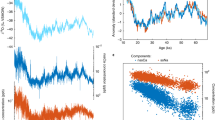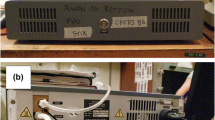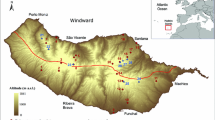Abstract
The gas phase concentration of hydrogen peroxide at Summit, Central Greenland, has been measured continuously during June/July 1990 using a coil scrubber technique combined with liquid phase fluorometry. The concentrations ranged between 0.3 ppbv and 3.5 ppbv, which is considerably higher than expected from model calculations and can be explained by low deposition rates. The record shows pronounced diurnal variations with minimum concentrations during night and maximum concentrations in the afternoon. The nocturnal minima can be explained by scavenging of H2O2 by hoarfrost. The scavenging mechanisms of H2O2 by snow and the redistribution of H2O2 during firnification are discussed. There is indirect evidence, that H2O2 is uniformly distributed in the ice lattice and that the fractionation between H2O2 and H2O is small during diffusional crystal growth from the vapor phase (co-condensation).
Similar content being viewed by others
References
Guntz D. W. and Hoffmann M. R. (1990) ‘Atmospheric chemistry of peroxides: A review’,Atmospheric Environment 24A, 1601–1633.
Logan J. A., Prather M. J., Wofsy S. C. and McElroy M. B. (1981) ‘Tropospheric chemistry: A global perspective’,J. Geophys. Res. 86, 7210–7254.
Rodhe H., Crutzen P. and Vanderpol A. (1981) ‘Formation of sulfuric and nitric acid in the atmosphere during long range transport’,Tellus 33, 132–141.
Schiavone J. A. and Graedel T. E. (1981) ‘2-D studies of the kinetic photochemistry of the urban troposphere, 1. Air stagnation conditions’,Atmospheric Environment 15, 163–176.
Kleinman L. I. (1986) ‘Photochemical formation of peroxides in the boundary layer’,J. Geophys. Res. 91, 10889–10904.
Penkett S.A., Jones B.M.R., Brice K.A. and Eggleton A.E.J. (1979) ‘The importance of atmospheric ozone and hydrogen peroxide in oxidizing sulfur dioxide in cloud and rainwater’,Atmospheric Environment 13, 123–137.
Chameides W. L. and Davis D. D. (1982) ‘The free radical chemistry of cloud droplets and its impact upon the composition of rain’,J. Geophys. Res. 87, 4863–4877.
Daum P. H., Kelly T. J., Schwartz S.E. and Newman L. (1984) ‘Measurements of the chemical composition of stratiform clouds’,Atmospheric Environment 18, 2671–2684.
Kelly T. J., Daum P. H. and Schwartz S. E. (1985) ‘Measurements of peroxides in cloudwater and rain’,J. Geophys. Res. 90, 7861–7871.
Calvert J.G., Lazrus A., Kok G. L., Heikes B. G., Walega J. G., Lind J. and Cantrell C.A. (1985) ‘Chemical mechanisms of acid generation in the troposphere’,Nature 317, 27–35.
Masuch G., Kettrup A., Mallant R. K. A. M. and Slanina J. (1986) ‘Effects of H2O2 containing acidie fog on young trees’,Int. J. Envir. Anal. Chem. 27, 183–213.
Möller D. (1989) ‘The possible role of H2O2 in new-type forest decline’,Atmospheric Environment 23, 1625–1627.
Jacob P. (this issue)
[18] Hov O and Isaksen I. S. A. (1987) ‘Model calculations of long-term changes in atmospheric hydroxyl, hydrogen peroxide and ozone from changes in the emissions of nitrogen oxides and methane’, in G. Restelli and G. Angeletti (eds.), Physico-Chemical Behaviour of Atmospheric Pollutants,COST Air Pollution Research Report 2 (Stresa), D. Reidel Publishing Company, Dordrecht, 633–639.
Thompson A.M., Owens M.A. and R.W. Stewart (1989) ‘Sensitivity of tropospheric hydrogen peroxide to global chemical and climate change’,Geophys. Res. Lett. 16, 53–56.
Lazrus A.L., Kok G.L., Lind J.A., Gitlin S.N., Heikes B.G. and Shetter R.E. (1986) ‘Automated fluorometric method for hydrogen peroxide in air’,Anal. Chem. 58, 594–597.
Dasgupta P.K., H. Hwang (1985) ‘Application of a nested loop system for the flow injection analysis of trace aqueous peroxides’,Anal. Chem. 57, 1009–1012.
Hwang H. and Dasgupta P. K. (1986) ‘Fluorometric flow injection determination of aqueous peroxides at nanomolar level using membrane reactors’,Anal. Chem. 58, 1521–1524.
Jacob P. (1987) ‘Wasserstoffperoxid in der atmosphärischen Gas- und Flüssigphasenchemie: Laborstudien und Felduntersuchungen’Ph.D. thesis, University of Dortmund.
Sigg A. and Neftel A. (1988) ‘Seasonal variations in hydrogen peroxide in polar ice cores’Annals of Glaciol. 10, 157–162.
Johnsen S.J. (1977) ‘Stable isotope homogenization of polar firn and ice’ in: Isotopes and Impurities in Snow and Ice, Proceedings of the Grenoble Symposium,International Association of Hydrological Sciences, Publication 118, 210–219.
Pruppacher H. R. and J. D. Klett (1978) Microphysics of clouds and precipitation, D. Reidel Publ. Co., Dordrecht, pp.
Hobbs P. V. (1974) ‘Ice Physics’, Oxford University Press, London, pp. 392–397.
Golecki I. and Jaceard C. (1978) ‘Intrinsic surface disorder in ice near the melting point’,J. of Physics 11, 4229–4237.
Giguère P.A. and Maass O. (1940) ‘Solid solutions of hydrogen peroxide and water’,Canadian J. of Research 18, 66–73.
Neftel A., Jacob P. and Klockow D. (1984) ‘Measurements of hydrogen peroxide in polar ice samples’Nature 311, 43–45.
Iribarne J. V. and Pyshnov T. (1990) ‘The effect of freezing on the composition of supercooled droplets-I. Retention of HCl, HNO3, NH3 and H2O2’,Atmospheric Environment 24A, 383–387.
Pruppacher H. R. and J. D. Klett (1978) ‘Microphysics of clouds and precipitation’, D. Reidel Publ. Co., Dordrecht, pp.
Schwerdtfeger P. and Weller G. E. (1977) ‘Radiative Heat transfer processes in snow and ice’, in J. A. Businger (ed.), Meteorological Studies at plateau Station, Antarctica,Antarct. Res. Ser. 25, Elsevier, New York, pp. 35–39.
Lind J. A. and Kok G. L. (1986) ‘Henry's Law determinations for aqueous solutions of hydrogen peroxide, methylhydroperoxide, and peroxiacetic acid’,J. Geophys. Res. 91, 7889–7895.
Sigg A. and Neftel A. (1991) ‘Evidence for a 50% increase in H2O2 over the past 200 years from a Greenland ice core’,Nature 351, 557–559.
Author information
Authors and Affiliations
Rights and permissions
About this article
Cite this article
Sigg, A., Staffelbach, T. & Neftel, A. Gas phase measurements of hydrogen peroxide in Greenland and their meaning for the interpretation of H2O2 records in ice cores. J Atmos Chem 14, 223–232 (1992). https://doi.org/10.1007/BF00115235
Published:
Issue Date:
DOI: https://doi.org/10.1007/BF00115235




